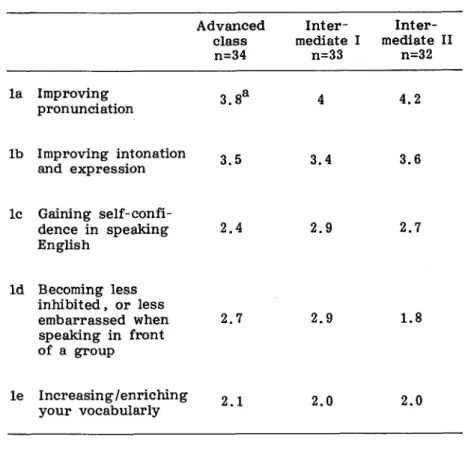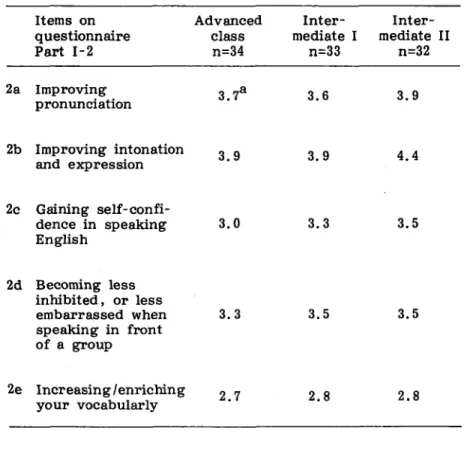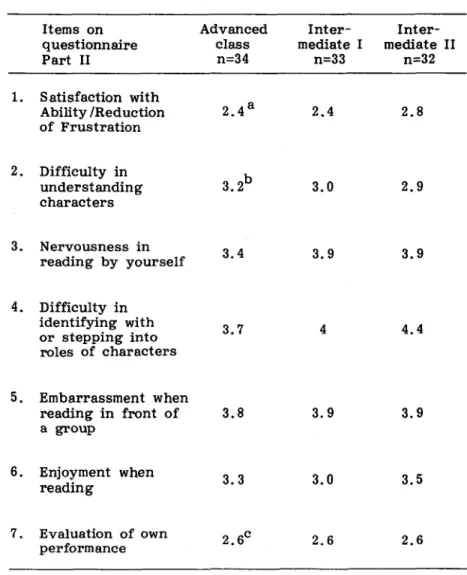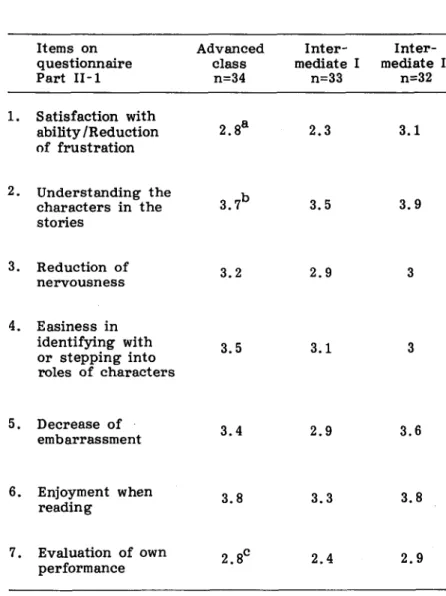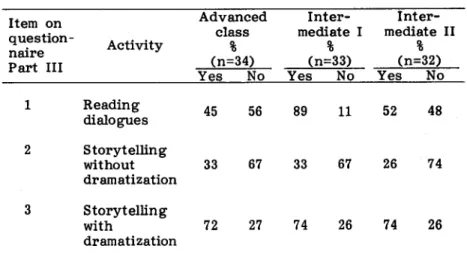DRAMA WORKS
IN TEACHING PRONUNCIATION
by Toshiko
Sakurai
Many teachers feel that teaching pronunciation is not rewarding. Aeoording to an investigation of the papers given at the 1978 TESOL convention, less than 2 percent dealt with pronuneiation (Gilbert: 1970). However, Lane (1963) reported that foreign-aceent speech was approximately 40 pereent less intelligible than native speeeh under all experimental conditions and the gap between understanding the foreigner and the native might have been expeeted to grow wider with
an increasing level of distortion. Since 'tcommunieability" is
our eoneern, we should not give up teaehing pronunciation and therefore we should seek effeetive methods in doing so. The aim of this paper is to present a proeess of developing effective methods by introducing four syllabi of my design. Two of them were found to be effective and the rest were ineffective. This is not a scientific paper supported by
researeh, but is a paper based on the eight-years
experiences of a group teaehersi who have struggled with
teaching pronuneiation at a junior college.
1. The Goal of the Syllabi
The goal is to lead the students to acquire aceeptable pronuneiation of a foreign language, i.e., English. In the context of my junior eollege the specifie goal is to develop
-113-oral paragraph reading ability, as this is neeessary for some
other eourses.
What does "oral reading" require the students to do? Researeh on miseue analysis indieates that it is just not a
matter of relating letters to sounds. Hudelson (1981)
.
summanzes:
Numerous analyses of native English speaking readers' oral reading and retelling have shown that even young readers are not bound to letter-by-letter processing of print. Rather readers use both selected visual cues and their knowledge of language and the real world to
antictpate, to predict, and to hypothesize about print. I have designed the syllabi to make the students integrate al1 the tasks required for oral reading.
2. General Course Work
The students practice segmentals as segmentals. In eaeh class, several elements The students are instructed to transeribe the
and sentenees to be practieed in the following
This is an effeetive way to relate letters to
(1984) advoeated this work:
well as supra-are emphasized.
words, phrases
elass by I.P.A.
sounds. Aetion
... the relationship between pronuneiation and orthog-raphy cannot be overemphasized. Many
mispronuneia-tions, espeeially with vowels, are simply a matter of the
students' not knowing the eorrect sound in a particular
environment or even realizing that it is being
mispronounced. To effeet significant and lasting change often requires developing a highly visual strategy, that is, a strong visual awareness or sensitivity to the shapes of words (see Diekenson 1975 and elsewhere).
-114-With the aid of their transeriptions, they learn how to use their arvticulatories. This work, as part of the foilowing
syllabi, has yielded varied results.
3. Syllabi
a. The First Syllabus
It took a year to eover the segtnentals and the suprasegmentals. Sentenees, dialogues and several short paragraphs were used to praetice. At the end of the eourse, the students reeorded several sentenees, a few dialogues and one paragrap.h, most of which were new to
them. They managed to read the sentenees and the
dialogues satisfaetorily but not the paragraph. The
paragraph reading was awkward, not natural. They
paused at the wrong places and stressed too many
words. I assumed that the paragraphs were meaningless to the students and that they did not motivate the students to learn how to eonvey the contents of the paragraphs and how to integrate the tasks necessar"y for oral reading. In the second syllabus therefore, a famous folklore tale was adapted instead of short paragraphs. I
believed that familiar content would motivate the students to retell the story and to develop oral reading skill.
b. The Second Syllabus
It took a year to cover al1 the segmentals and the suprasegrnentals. Dialogues and one folklore tale were practiced. By the end of the course, the students read sentenees and dialogues well. Again, however, many
failed to read a paragraph satisfactorily. They seemed to
have reached a plateau at sentence and dialogue level
-115-c.
and were not able to go beyond that level. Reading a ful1 paragraph was beyond their skills. Altbough I oould not deduce the eauses of the fallure, the syllabus was drastieany ehanged to find a more effeetive way to teach
pronunciation.
Third Syllabus
Most of the segmentals as well as the
supra-segrnentals were covered in the spring term. Dialogues were used for praetice. In the fal1 term, a skit, two short paragraphs and three or four short stories were
utilized. The paragraph and some of the stories
eontained dialogues in them. Dramatization was the purpose of using the skit, the paragraphs and some of the stories. With the dramatization I tried to create a co-operative atmosphere and to put the students into the world of the reading materials. I thought this would
help the students realize thatoral reading is not just the
work of relating letters to sounds, but the work of
conveying meanings. Most of the materiats were
dramatized first and then read individually. At the end
of the year about two thirds of the students attained the
goai of good pronunciation. Their artieulation was not awkward. They stressed the appropriate words and their
intonation was expressive. I used a questionnaire to find
out the students' reactions to the dramatization. This wi11 be discussed later. This syllabus was powerful, but to increase the number of successful students it was
modified a little.
d. The Fourth Syllabus
The syllabus for the spring term remained the same. In the fal1 term, two new works were added to the skit, paragraphs and short stories. The students were asked to reeord a short paragraph at home. No elass instruetion was given for this work. Their reading was
evaluated and some comments were made. The model
reading tape was then given out and the students were asked to re-record the same paragraph. In this way they read three or four psragraphs in the fal1 term. The other work involved spontaneous reading. A story of about 800 words was distnibuted and 20 minutes were alloted to understand the content. Then the story was diseussed. After the discussion, the students were asked to practiee oral reading for 15 minutes. Afterwards some of the students were asked to read a few sentenees. Some were asked to read half of the story and some the whole story. Their reading was understandable. At the end of the year, more than two thirds of the students
read a paragraph at a comprehensible level. No
questionnaire has yet been used to ascertain the
effectiveness of the newly added works. Interestingly,
the students seemed to diseover strategies for
integrating all the tasks necessary for oral reading in this syllabus. This syllabus will be tried again to see
whether it is not a "hit and miss" type of prograrn.
Of the above mentioned syllabi, the third and the fourth were effeetive. The key faetor in these syllabi was dramatization. In the following seetions, the
students' reactions to the aetivities of the third syllabus
wi11 be discussed in order to find out why the
- 117dramatization worked.
4. The Students' Reactions
The questionnaire was used to see how the students reacted to the dialogue reading, to the dramatization and to the individual storytelling after the dramatization. This questionnaire, a modified version of Stern's questionnaire2 that had been developed to find out the effeetiveness of dramatization, is found in the appendix. It was eompleted by three elasses; one advaneed and two intermedlate elasses at the end of the third syllabus year. There were 34 students in the advaneed elass and some of them had lived in English speaking eountries. The number in the intermediate I and II
were 33 and 32 respectively.
Part I asked the students to evaluate the usefulness of
the dialogues practiced in the spning term and the
storytelling in the fall term. Table 1 and 2 list the means ofeaeh item in this part. Table 3 shows the differenees between the dialogue and the storyterang. Interestingly, the students
said the storytelling was less effeetive in improving
pronuneiation. However, it was good for improving intonation and expression. Storytelling worked better in helping the students gain confidence in speaking English and in redueing
their embarrassment.
-118-Table 1. Meansof ltems on Questionnaire on the Dialogues3 Advaneed class n=34 Inter-mediate I n=33 Inter-mediate Il n=32 la Improving pronunciation lb Improving intonation and expression lc Gaining denee in speaking English ld Beeoming les$ inhibited, or less embarrassed when speaking in front of a group le Inereasing/enriehing your vocabularly 3.sa 3.5 2.4 2.7 2.1 4 3.4 2.9 2.9 2.0 4.2 3.6 2.7
L8
2.0a The figures are based on the following
response: 1-not suecessful; 2-a little useful; useful; 4-quite useful; 5-very useful
Likert seale
3-somewhat
--Table 2. Means of ltems on Questionnaire on the Storytelling Items on questionnaire Part I-2 Advanced class n=34 Inter-mediate I n=33 Inter-mediate II n=32 2a Improving pronunciation 3.7a 3.6 3.9 2b Improving intonation and expression 3.9 3. 9 4.4 2e Gaining dence in English speaking 3.0 3.3 3.5 2d Beeoming less inhibited, or less embarra,ssed when speaking in front of a group 3. 3 3.5 3.5 2e Inereasing/enriching your vocabularly 2.7 2.8 2.8
a The figures are based on the following response: 1-not successful; 2-a little useful; useful; 4-quite useful; 5-very useful
Likert scale
3-somewhat
-Table 3. The and
Differences the Dialogue
betweenthe Storytelling
Advanced elass n=34 Inter-mediate I n=33 Inter-mediate II n=32 a Improving pronuneiation b Improving intonation and expression e Gaining denee in speaking English d Becoming less inhibited, or less embarrassed when spealdng in front of a group e Increasing/enriehing your vocabularly a-O.1 +O.4 +O.6 +O.6 +O.6 -O.4 +O.5 +O.4 +O.4 +O.8 -O.3 +O.8 +O.8 +1.7 +O.8 a
+ means
storytehing gained morethat the students
than in the dialogue
in the dialogue than
gained more in
while - means that in the storytehing.the they
Part II asked the students to indieate how they felt about dramatizing the stories with their elassmates and
reading them individually. Two elasses said they were
somewha" satisfied with the dramatization. These two said thedramatization somewhat helped them reduce both nervousness and embarrassment. All the elasses said it somewhat helped them understand the eharacters in the stories and identify
with the roles of the eharacters.
In the storytelling, on the other hand, which was an
individual work, they were more than somewhat nervous and embarrassed. Two classes said understanding the characters
'
was somewhat difficult. All said identifYing with the
'
eharaeters was quite5difficult. However, all of the classes
somewhat enjoyed both the storyteMng and the drarnatization.
-Table 4. Student Reaction to Storytelling Items on questionnaire Part II Advaneed elass n=34 Inter-mediate I n=33 Inter-mediate Il n=32 1. Satisfaetion with Ability /Reduetion of Frustration 2.4a 2.4 2.8 2. Difficulty in understanding eharacters
b
3.2 3.0 2.9 3. Nervousness in reading by yourself 3.4 3. 9 3. 9 4. Diffieulty in identifying with or stepping into roles of eharaeters 3.7 4 4.4 5. Embarrassment when reading in front of a group 3.8 3.9 3.9 6. Enjoyment reading when 3.3 3.0 3.5 7. Evaluation ofperform anee
own
2.6C 2.6 2.6-aThe figures in the
following likert seale:
12
Overal1 I was
displeased withmy ability. I
felt frustrated. first seetion34
are based on the
5
Overat1 I was
pleased with my ability. I felt Iwas able to
express myself
with ease. bThe figures in the
following scale:12
not at all a little
seeond seetion are
34
somewhat quite
based on 5 very much theeThe figures in the
following Likert scale:12
I didn't like it.It was worse
than I though it would be. third section34
About average are based 5 ! likemuch.
better thought be. on the it veryIt was
than I
it would 124-Table 5. Student Reaction to Drama ltems on questionnaire Part II-1 Advaneed class n=34 lnter-mediate I n=33 Inter-mediate II n=32 1. Satisfaetion with ability/Reduction of frustration 2.sa 2.3 3.1 2• Understanding the eharaeters in the stories 3.7b 3.5 3. 9 3. Reduction of nervousness 3.2 2.9 3 4. Easiness in identifying with or stepping into roles of charaeters 3.5 3.1 3 5. Decrease of embarrassment 3.4 2.9 3,6 6. Enjoyment reading
when
3.8 3.3 3.8 7. Evaluation of performanceown
2.sC 2.4 2.9 125-a
The figures in the first seetion
following Likert seale: are
based on
the 1 2 3 4 5
Overal1 I was
displeased withmy ability. I
felt frustrated.Overall I was
pleased with my ability. I felt Iwas able to
express myself with ease. b The figures infollowing scale: the second section are based on the
1 2 3 4 5
not att all a little somewhat quite very
mueh
eThe figures in the third seetion
following Likert seale: are
based on
the
1 2 3 4 5
I didn't like it.
It was worse
than I tbough it would be. I like mueh. better thought be. it veryIt was
than I
it would 126Though they reported they were more than somewhat embarrassed when reading the stories in front of the elass, they still suggested they were less inhibited and less embarrassed when reading the stories than reading 'the
dialogues (Table 3a).
From this questionnaire, we can get abetter idea of the effeetiveness of the dramatization. Firstly, it helped the students understand the eharacters and identify with them. Seeondly, it redueed inhibition and embarrassment. Drama functions as a group effort, giving safety through numbers
(Stern: 83). In this group activity it was easier for them to identify with the eharaeters and to deliver the intonation and
expression which fitted. This carried over into the
storytelling. The students' report in part II supportsthis earry-over. They reported that the storytelling was good for improving intonation and expression. Their involvement in delivening the stories drew their attention away from the segmentals. Table 3 a and b support this. However, as the
segmentals had been praeticed intensively in the spning term,
they did not deviate from the eomprehensible level. At the same time, the inhibition and the embarrassment of the students were found to be more redueed in the storytelling than in the dialogue. These reduetions made the students concentrate on the suprasegrnentals. Thus a lot of the
students eould attain the goal of good pronunciation.
-Table 6. Activities to be Desired Item on . natre Par't III Aetivity Advaneed elass g (n=34)
Yes No
Inter-mediate Ig
(n=33) Inter-mediate II ? (n=32) Yes No YesNo
1 2 3 Reading dialogues Storytelling without dramatization Storytelling with dramatization 45 33 72 56 67 27 89 33 74 11 67 26 52 26 74 48 74 26Part III of the questionnaire asked about activities the
students desired. More than 70 pereent wanted to dramatize
stories and read them individually (Table 6).
The students' responses to the questionnaire reveal the
causes of the failures with the first and the seeond syllabi.
In spite of the faet that a lot of the students attained the
goal with the fourth syllabus, they said it was still difficult
for them to identify with the eharaeters when reading the stories by themselves, even after the drarnatization. Without the dramatization, it might have been much harder to do so. Besides, mueh embarrassment and great inhibition might have prevented them from delivering appropriate intonation and expression. Consequently, they stressed too many words and
eoncentrated too much on the segrnentals. This led to
exaggerated and awkward oral reading.
-5. Conclusion
Failures in teaehing oral reading led me to the most
effeetive syllabi. These syllabi were powerful in the reduetion of inhibition and in encouraging 'identification with charaeters
in the stories. Although it is surprisingly time eonsuming to carry out the ideal syllabi, I ean eonelude that it is
rewarding when I hear that native speakers of English
understand what the students say and also when I see them doing English aetivities. I want to encourage you who are struggling with teaching pronunciation to keep looking for
more effective ways appropriate to your own eontext.
NOTES
1. I owe a lot to Ms. Yasuyo Edasawa vvho was a co-teaeher at Osaka Jogakuln Junior CoUege. However, I am solely
responsible for the content of this paper.
2. See Stern's questionnalre in the appendix of Stern
(1983).3. The formats of the tables on the questionnaire are Stern's. 4. 'Somewhat' indieates 3 on the following Likert Seale.
12345
not at al1 alittle somewhat quite very mueh
5. 'Quite' indieates 4 on the following riikert Seale.1 2 3 4 5
not at all alittle somewhat quite very much
-Part 1. a) b) e) d) e) f) APPENDIX Evaluation of the Course
1: Circle the number that most closely refleets your
opinion .
DIALOGUES PRACTICED IN THE SPRING TERM
How useful were they for you in eaeh of the following
areas?
Not A little Somewhat Quite Very
useful useful useful useful usefu1
Improving pronuneiation Improving intonation and .expresslon Gaining self-eonfidence in speaking English Beeoming less inhibited, or less embarrassed when speaking in front of a group Increasing/ enriehing your voeabulary Did they help you improve .your pronunela-tion ? Please expalin. 1 1 1 1 1 2 2 2 2 2 3 3 3 3 3 4 4 4 4 4 5 5 5 5 5 130
-2.
STORIES READ IN THE
How useful areas? were they Not useful a) Improving pronuneiation b) Improving intonation and . expresslon c) Gaining eonfidenee in speaking English d) Becoming less inhibited, or less embarrassed when speaking in front of a group e) Increasingl enriching your Voeabularyf) Did they help . you lmprove . your
tion? •
Please expalin. 1 1 1 1 1FALL TERM
for you in each
A little Somewhat useful useful
23
2 2 2 2 3 3 3 3 of the followingQuite Very
useful useful45
4 4 4 4 5 5 5 5This questionnaire was copied from "Why Psyeholinguistie Perspeetive" by Susan
modifieation. This article appears in Methods
by John W. Oller, Jr. and Partrieia A.
Newbury House, 1983. 131
-Drarna Works: A
L. Stern with
that Work editedPART 11
STORYTELLING
1. Think back to when you were reading the stories after drarnatization, and try to remember how you felt about
your ability to express yourself in English at that time.
Overall I was pleased with my
Overall I was ability.rfeltl
displeased with was able to
my ability.Ifelt express myself
very frustrated. with ease.
1 234 5
2. How difficult did you find it to understand the
eharacters you were reading?
Not at all Very
diffieult A little Somewhat Quite diffieult
1 2 3 4 5
3. How nervous did you feel when reading by yourself?
Not at all Very
nervous Alittle Somewhat Quite nervous
12345
4. How difficult did you find it to identify with, or step into the roles of the eharaeters you were reading?
Not at all Very
difficult A little Somewhat Quite diffieult
1 2 3 4 5
5. How embarrased did you feel when reading in front of the class?
Not at al1 Very
embarrased A little Somewhat Quite embarrased
1 2 3 4 5
6. How mueh did you enjoy reading?
Not at al1 A little Somewhat Quite Very mueh
12345
-7. How
would you evaluate YQurown
performance? I didn'tIt was
than I it would 1 like it. worse thought be. 2 About average3
4 I like mueh. better thought be. it veryIt was
than I
it would 5DRAMATIZATION
1. Think
dramas abilitybaek to
, and try to expresswhen you were partieipating in to remember how you felt about
yourself in English at that time?
the your
Overal1 I was
displeased with my ability. I felt very frustrated. 1 2 3 4Overall I was
pleased with my ability. I felt Iwas able to
express myseif with ease. 5 2.How
the mueh did it stories?help you understand the eharaeters in Not at al1 1 A little 2 Somewhat 3 Quite
4
Very 5mueh
3. How
mueh did it help you reduee your nervousness?Not at all 1 A little
2
Somewhat3
Quite 4 Very5much
4.How
rolesmueh did it help
of the characters youof
identify with, or the stories?
step into the
Not at al1 1 A little 2 Somewhat 3 Quite
4
Very5
mueh
5. How
mueh did it help you ease your embarrassment?Not at al1 1 A little
2
Somewhat3
- 133 --Quite 4 Very5mueh
6. How much did you enioy partieipating in the drarnas?
Not at all A little Somewhat Quite Very much
12345
7. How would you evaluate your own performance? I like it veTvy
Ididn't like it. mueh. It was
It was worse better than I
than I thought About thought it would
it would be. average be.
1 234 5
PART 111
1. Would you like to read the dialogues as you did in the spring term?
Yes No
2. Would you like to read the stories without dramatization?
Yes No
3. Would you like to read the stories with dramatization?
Yes No
BIBLIOGRAPHY
Acton W. Changing Fossilized Pronunciation. TESOL
Quarterly, Vol. 18, No. 1, March 1984.
Bailey, K.M. An introspeetive analysis of an individual's
language learning experience. In S. Krashen & R.
Searcella (Eds.),'Research in Second Language
Acquisition: Selected Papers of the Los Angeles Second
Language Research Forum. Rowley, Mass: Newbury
House, 1979. .
'
-134-Bailey, K.M. Competitiveness and anxiety. In H.W, Seliger &
M.H.Long (Eds.), Classroom Oriented Research in
Second Langauge Acquisition. Rowley, Mass. Newbury House, 1983.
Guiora, A., B. Hallahmi, R. Brannon, C. Dull, and T.
Scovel. The effects of experimentally indueed ehanges in
ego status on pronunciation ability in a seeond language:
an exploratory study. Comprehensive Psychiatory, 1972,
13: 421 - 428.
Johansson, S. Studies of Error Gravity. GOteborg, Sweden, Acta Universitatis Gothoburgensis, 1978.
Lane, H. Foreign Accent and Speeeh Distortion. In S.
Johansson, Studies of Error Gravity. G6teborg Sweden.
Aeta Universitatis Gothoburgensis, 1978.
Scovel, T. The effeet of affeet on foreign lariguage learning:
A review of the anxiety researeh. Language Learning,
1978, 28, 129 - 142.
Stern, S.L. Why Drama Works: A Psycbolinguistic
Perspeetive. In J.W. Oller and P.A. Richard-Amato
(Eds.), Methods That Work. Rowley, Mass: Newbury
House, 1983.
(Received May 19, 1986)
